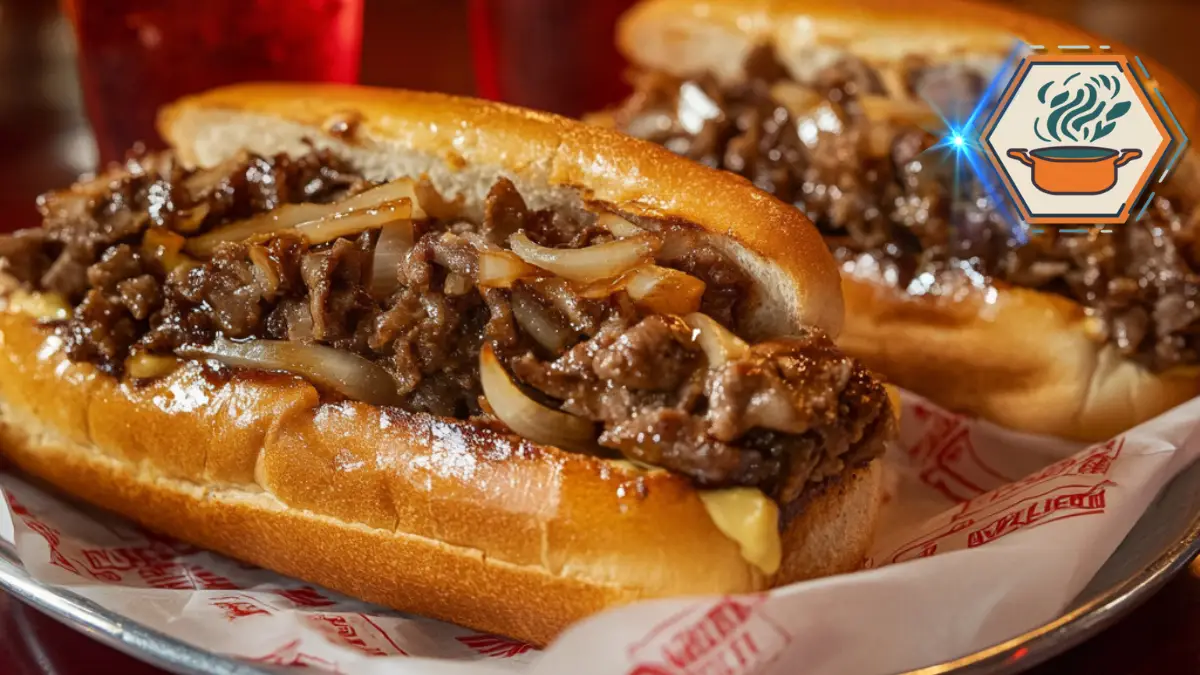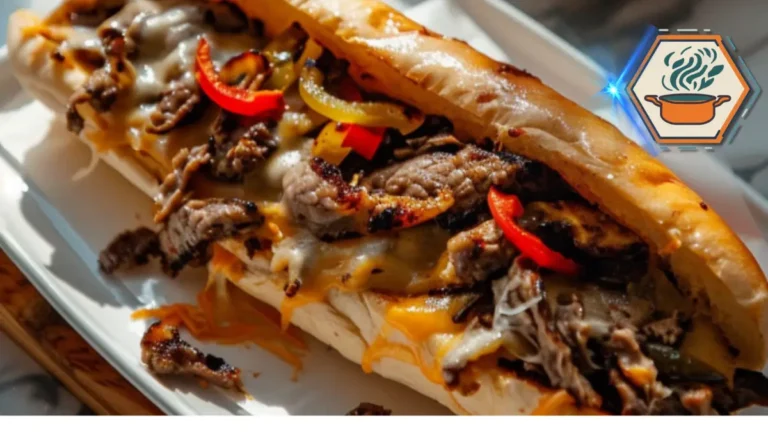
Philly Cheesesteak – Authentic Flavor at Home
Learn how to make the perfect Philly cheesesteak with ribeye, onions, and melted cheese in a soft roll. Authentic taste, straight from Philly!
- Total Time: 20 min
- Yield: 2 sandwiches
Ingredients
1 lb ribeye steak, thinly sliced
1 medium onion, thinly sliced
4–6 slices cheese (Cheez Whiz, provolone, or American)
2 hoagie rolls (Amoroso style if possible)
½ cup green peppers (optional)
1–2 tbsp butter or oil
Salt & pepper, to taste
Instructions
Heat a skillet or griddle over high heat.
Sauté onions (and peppers) in butter until golden.
Add thin-sliced ribeye, season lightly, and cook 2–3 minutes.
Place cheese over hot beef and let it melt.
Toast rolls in buttered pan until crisp.
Fill rolls with cheesy beef and onions. Serve hot.
Notes
For extra authenticity, use Amoroso rolls and Cheez Whiz. Serve with fries or pickles.
- Prep Time: 10 min
- Cook Time: 10 min
- Category: Sandwich
- Method: Griddle / Skillet
- Cuisine: American
JUMP TO
Time to read:21 minutes
Philly Cheesesteak Origins – A Sandwich Born in South Philly
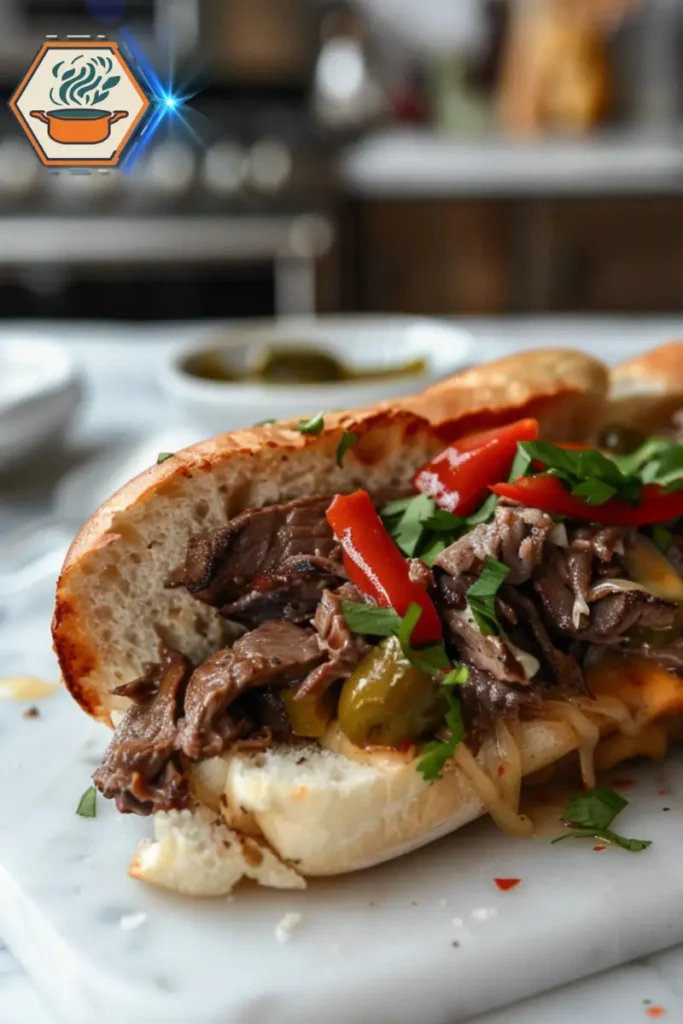
Philly cheesesteak is more than food—it is Philadelphia on a roll. Born in South Philly in the 1930s, when Pat and Larry Olivieri turned a hot dog stand into legend, this sandwich became the city’s pride. Imagine the sizzle of thin beef on the grill, the smell of onions caramelizing, and the first bite of melted cheese on a soft roll. That’s the real Philly cheesesteak experience.
Philly cheesesteak beginnings: the story of Pat and Harry Olivieri
Philly cheesesteak began with the Olivieri family. Pat Olivieri created the first version. He sliced beef thin, cooked it on a real grill, and placed it on an Italian roll. It was meant to be a meal for workers. It was sold from a hot dog stand. Gradually, more people asked for that beef sandwich. authentic Philly roll was born out of necessity. It was born in modesty. It was born for taste.
From hot dog stand to Philly icon: the early days
Philly cheesesteak was originally cooked on a small grill. It was served with fried onions. Cheese was added later. Cheese would become a defining touch. Yet in the start, some customers preferred just beef and onions. Then the sandwich stand moved. Then a storefront grew. cheesesteak sub was no longer street food only. People came from far. They came from surrounding neighborhoods. They came to taste it.
Why Philly? The city that made it legendary
Philly cheesesteak owes its soul to the city. In the 1930s, Philadelphia’s steel mills roared, and workers needed food that was quick, hearty, and cheap. The sandwich became more than fuel—it was comfort in hard times, a taste of pride in every bite, and a way for neighbors to connect after long shifts. Food that was hearty was needed. The beef and cheese sandwich matched that need. The roll could hold juice. The meat could fill hunger. And yet, Philly cheesesteak was shared and loved across classes. It was sold in diners, lunch counters, and food carts. The city nurtured it. It spread because it could survive hard times.
How it became more than just a sandwich
Philly cheesesteak grew into more than a meal. It became folklore. It became a test of loyalty. It became about which shop made it best. Who served the right cheese? Who cooked the onions right? Who toasted the roll well? It became a debate. It was discussed in family kitchens. It was argued over in shop lines. cheesesteak sub was about taste and pride.
The cultural pride behind the Philly cheesesteak
The iconic cheesesteak carried pride. Philadelphians saw it as their symbol. Philadelphians defended it fiercely. Outsiders tried to imitate. But authenticity mattered. For many, Philly cheesesteak meant authenticity. For others, it meant remembering roots. For many immigrants, it meant chance. For many locals, it meant home.
Secret ingredient behind the classic version (with internal link to Secret Ingredient for authentic Philly roll)
One secret ingredient sets the classic version apart. That secret ingredient is Cheez Whiz. It changed how cheese was used. Instead of sliced cheese, the rich sauce came. Then American cheese and provolone were added. Yet Cheez Whiz keeps its fans. Traditional shops still offer it. Some will meet patrons halfway: onions caramelized gently. Other toppings are optional. Yet that original taste lives. You can read more about that in the internal article on the Secret Ingredient for Philly Cheesesteak.
Did it always have cheese? The birth of “Whiz”
Philly cheesesteak was first a meat-and-onion affair. When did cheese appear? It came later. At first, provolone was used. Then Whiz was created in the 1950s. cheesesteak sub changed with it. Whiz gave the sandwich creaminess. It gave bold flavor. Not everyone liked it. Some preferred mild cheese. Some preferred no cheese. But Whiz helped to define what “cheese steak” meant.
Classic vs modern: What’s changed since the 1930s?
In a table below, we compare the original Philly cheesesteak with modern versions. This helps to see what stayed and what evolved.
| Feature | Original Philly Cheesesteak (1930s–1950s) | Modern Philly Cheesesteak |
|---|---|---|
| Meat cut | Thin slices of rib-eye or similar beef | Sometimes chopped meat or alternative cuts |
| Cheese style | No cheese at first; then provolone; then Whiz | Various types: provolone, Whiz, American, or blends |
| Bread roll | Soft Italian roll, steamed | Sometimes toasted, sometimes different rolls |
| Onions | Simple fried onions | Caramelized, grilled, sometimes mixed veggies |
| Extras | Rarely beyond meat, cheese, onions | Peppers, mushrooms, extra sauces, custom orders |
Philly cheesesteak has changed in texture. It has changed in taste. Yet the core stays: beef, roll, cheese, onions.
Regional debates: Philly vs out‑of‑town versions
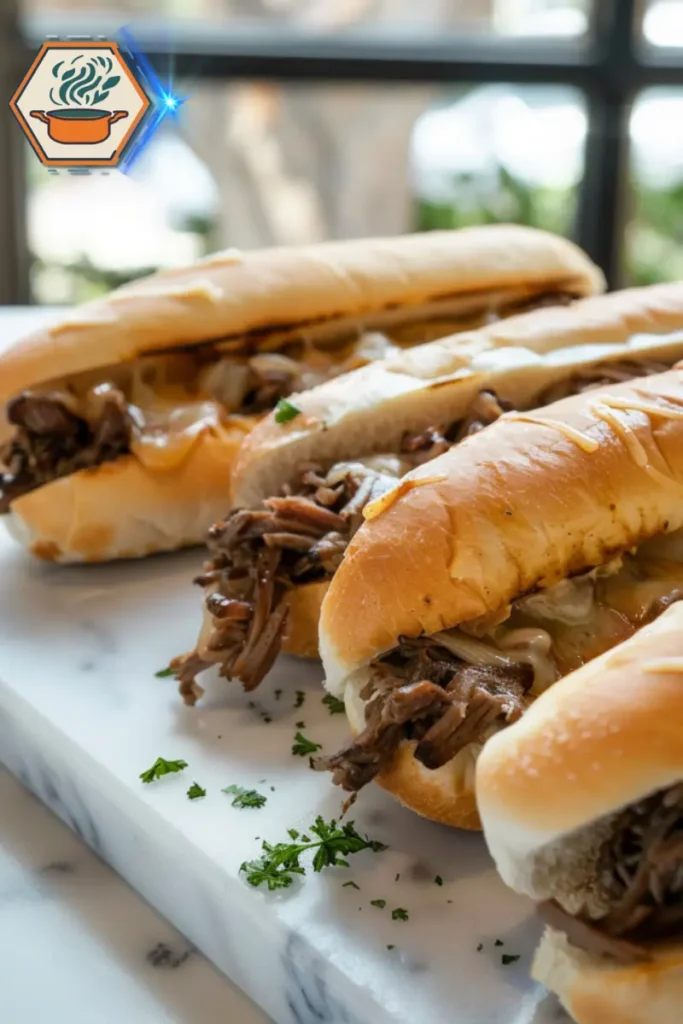
Philly cheesesteak is copied widely. But many outside Philadelphia miss key details. Rolls get replaced. Meat is sliced thicker. Cheese is changed. Or cheese is skipped. Sometimes too much filler is used. Sometimes flavor is lost. Philly cheesesteak outside Philly can be heavy. Sometimes it’s soft or soggy. Authentic shops work hard to protect the tradition. And still, authentic Philly roll is interpreted differently across the country.
Impact of immigration and evolving tastes on Philly cheesesteak
Immigrants brought flavor. Immigrants brought spice. Immigrants brought new cheese or bread styles. That impacted Philly cheesesteak. New shops offer versions with peppers or jalapeños. Some use sharp cheddar. Some use garlic rolls. Yet even in modern homes, people cook a version close to original. They honor Philly cheesesteak by keeping beef thin. They keep onions tender. And they keep roll soft.
Media and Philly cheesesteak: how it became famous
It was shown on TV. It was written about in magazines. When travel shows visited Philadelphia, they featured Philly cheesesteak. They showed lines. They showed melted cheese. They showed messy bites. Because cheesesteak sub looks good in photos. Because flavor mattered, stories were told. Because Philly cheesesteak came to represent Philadelphia to outsiders.
Preservation of tradition vs innovation in Philly cheesesteak
Innovations appear. Some shops offer vegan versions of Philly cheesesteak. Some offer chicken instead of beef. Some offer gluten‑free rolls. Some add spices or sauces unexpected. Yet many shops refuse to deviate. They say tradition matters. They say Philly cheesesteak is defined by beef, onions, cheese on an Italian roll. That balance is critical. If one piece shifts too far, it stops being classic.
How Philly cheesesteak influences local identity and tourism
Tourists come to try it. They go to shops that claim the original. They ask locals where to find the best Philly cheesesteak. They compare shops. They take photos. They share on social media. They bring the sandwich home. cheesesteak sub becomes attached to Philadelphia’s image. And so, local shops use signage that claim tradition. Local culture uses Philly cheesesteak in festivals. Local tours include it.
Lessons from Philly cheesesteak for food makers today
Philly cheesesteak teaches:
- Simplicity can win.
- Authentic taste draws people.
- Stories matter.
- Small differences (cheese type, onion style) can define a brand.
- Change is okay, if respect stays.
Philly cheesesteak has remained strong for decades. It was shaped by many. It continues to evolve. Yet it stays loyal to its roots.
Philly Cheesesteak Ingredients and What Makes It Truly Authentic
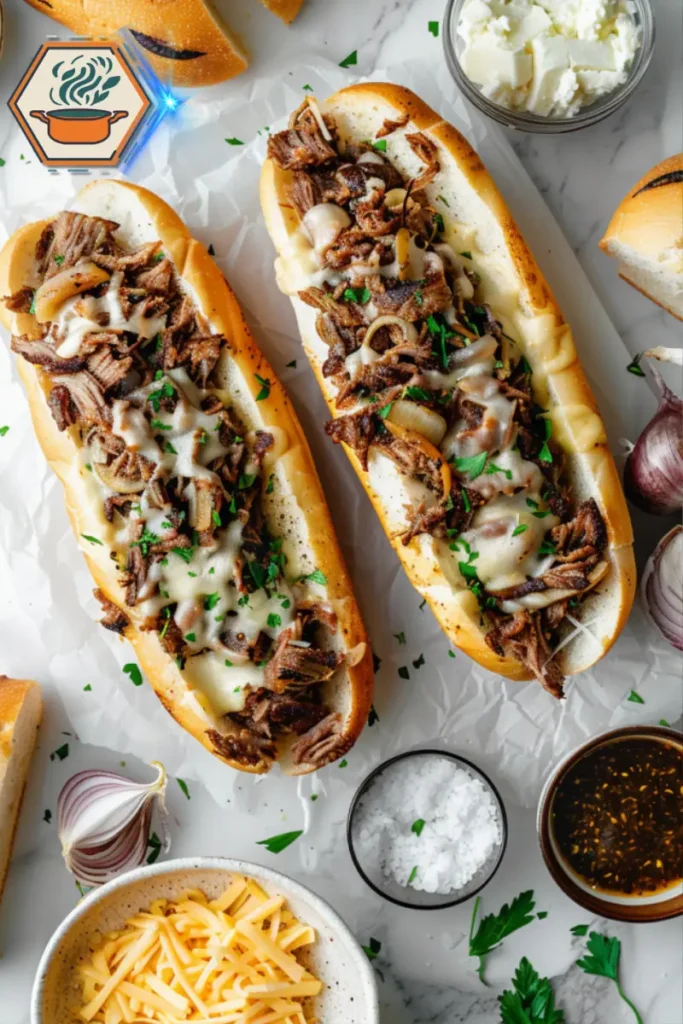
What beef cut brings the true flavor?
The ingredients for a cheesesteak start with the right beef. Thin-sliced ribeye is the top choice. It’s juicy, flavorful, and tender. Some use sirloin or top round, but these lack the natural fat marbling that ribeye offers. This marbling is key—it adds richness and keeps the sandwich moist. Thin slices also cook fast, preventing dryness.
Local butchers can often provide pre-sliced ribeye, or slice it for you if you ask. The texture and taste of fresh meat matter. You can also get ideas on selecting top meat in this guide to perfect meatloaf every time, which highlights the importance of beef quality.
Best cheese for the job: Whiz, provolone or American?
The cheese debate in philly cheesesteak culture is serious. Some say only Cheese Whiz is right—it melts fast and coats the meat evenly. Others prefer provolone for its sharp, aged flavor. Then there’s American cheese, smooth and mild, melting easily into the sandwich. For a full breakdown of which one truly wins, check our guide to the best cheese for Philly cheesesteak.
There’s no universal rule. Many cheesesteak shops offer all three, letting customers choose. Still, Cheese Whiz remains the traditional pick, especially in Philly. No matter your choice, meltability and flavor should guide your decision.
The importance of the roll: best bread for Philly Cheesesteak
Bread is more than a container—it’s part of the experience.The best bread for cheesesteak is a soft roll that holds moisture without falling apart. Amoroso rolls, baked in Philadelphia, are iconic. They’re slightly chewy inside and crispy outside, perfect for holding juicy meat and cheese.
In other regions, use a hoagie roll that mimics the Amoroso texture. Avoid crusty baguettes or overly soft sandwich rolls. A toasted inside adds crunch and protects from sogginess, creating that ideal bite.
Essential toppings vs controversial ones
Classic philly cheesesteak toppings are onions and sometimes peppers. That’s it. Purists often reject extras. Mushrooms are tolerated by some, but rarely considered traditional. Other add-ons like lettuce, tomatoes, mayo, or mustard shift the sandwich away from its roots.
Focus on balance: rich meat, creamy cheese, sweet onions. Overloading with sauces or veggies hides the true flavor. In a dish like sweet potato pie, simplicity is also key—let ingredients shine on their own.
How onions and peppers became the norm
Why are onions and green peppers so common in a philly cheesesteak? Onions add sweetness and moisture. Caramelized gently, they blend into the meat. Green peppers give crunch and brightness. This pairing became popular in Philly due to cost and availability.
In fact, original cheesesteaks had only meat and onions. Over time, peppers joined the mix at diners and street carts. But still today, the simplest version—just beef, cheese, and onions—is often the favorite.
Chicken Philly Cheesesteak: is it still authentic?
Some claim the chicken cheesesteak is a different dish. Instead of beef, it uses thinly sliced grilled chicken breast. Everything else stays the same—cheese, onions, peppers, and the roll.
Is it authentic? Purists say no. Yet many love it as a lighter option. Chicken versions are now found on menus across the U.S. If done right, with the same attention to ingredients, it’s still delicious.
Homemade or takeout? Where taste meets convenience
Making a philly cheesesteak at home is easier than it seems. You need a hot griddle or cast iron pan, thin beef, good bread, and quality cheese. The trick is in the quick cooking. Thin meat sears fast. Add cheese, melt, serve in a toasted roll.
Takeout is fast and often satisfying. Philly locals swear by neighborhood shops. But at home, you control the ingredients, size, and cheese blend. If you’re into home cooking, our banana bread preparation guide shows how technique and timing bring results.
Authentic Philly Cheesesteak recipe you can make at home
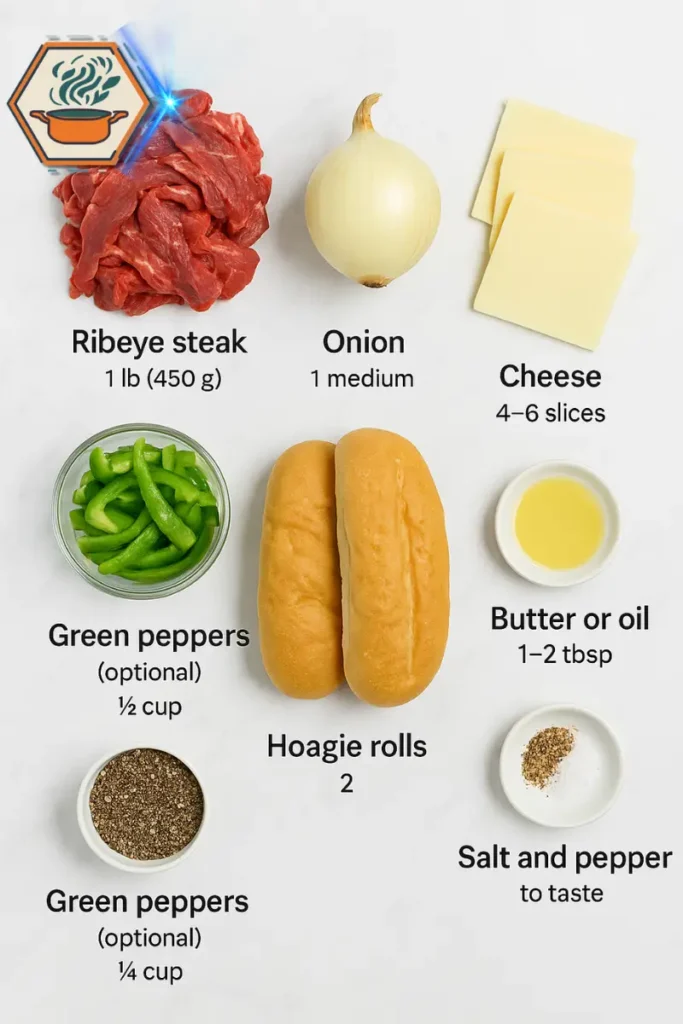
Here’s a simple, authentic recipe:
| Ingredient | Amount | Notes |
|---|---|---|
| Ribeye steak | 1 lb (450g) | Sliced paper-thin |
| Onion | 1 medium | Sweet yellow, sliced thin |
| Cheese | 4–6 slices | Whiz, provolone, or American |
| Hoagie rolls | 2 | Preferably Amoroso-style |
| Green peppers (opt.) | ½ cup | Sliced, sautéed |
| Butter or oil | 1–2 tbsp | For cooking meat and toasting roll |
| Salt and pepper | To taste | Keep it simple |
Steps:
- Heat pan or griddle to high.
- Add butter/oil, sauté onions (and peppers) until soft.
- Cook beef until just browned, season lightly.
- Add cheese on top to melt, mix gently.
- Toast roll in buttered pan.
- Stuff roll with hot cheesy meat mix. Serve hot.
Common mistakes to avoid when shopping for ingredients
- Wrong meat cut: Avoid lean beef like round. No fat = no flavor.
- Cheese that doesn’t melt: Skip cheddar blocks or hard aged cheese.
- Cheap rolls: Soft sandwich bread gets soggy. Use hoagie-style only.
- Burning onions: They should be golden, not dark brown.
- Overloading toppings: Keep it classic to stay true to the dish.
From butcher to baker: sourcing quality locally
Fresh ingredients make the difference. Ask your local butcher for fresh-sliced ribeye. Visit bakeries for freshly baked rolls. Quality matters more than quantity. Avoid frozen or overly processed cheese. Go to local shops instead of big box stores when possible.
To better understand how sourcing affects your food, the USDA Meat & Poultry Guidance explains how to identify safe, fresh products. You can apply these principles when picking meat for your next Philly sandwich. For example, look for labels like “fresh, not frozen,” check inspection and origin labels, and verify the temperature and handling history — these are all explained in the FSIS USDA guidance on fresh meat labeling.
Cooking the philly cheesesteak – Step-by-Step with Pro Tips
How to prep your steak the traditional way
Philly cheesesteak starts with choosing the right beef. Use ribeye or top round. Chill it in the freezer just enough so it’s firm but not frozen solid. That makes thin slicing easier and more even. Then let it rest at room temperature for a few minutes before cooking. This helps cook more evenly.
Why freezing before slicing makes a difference
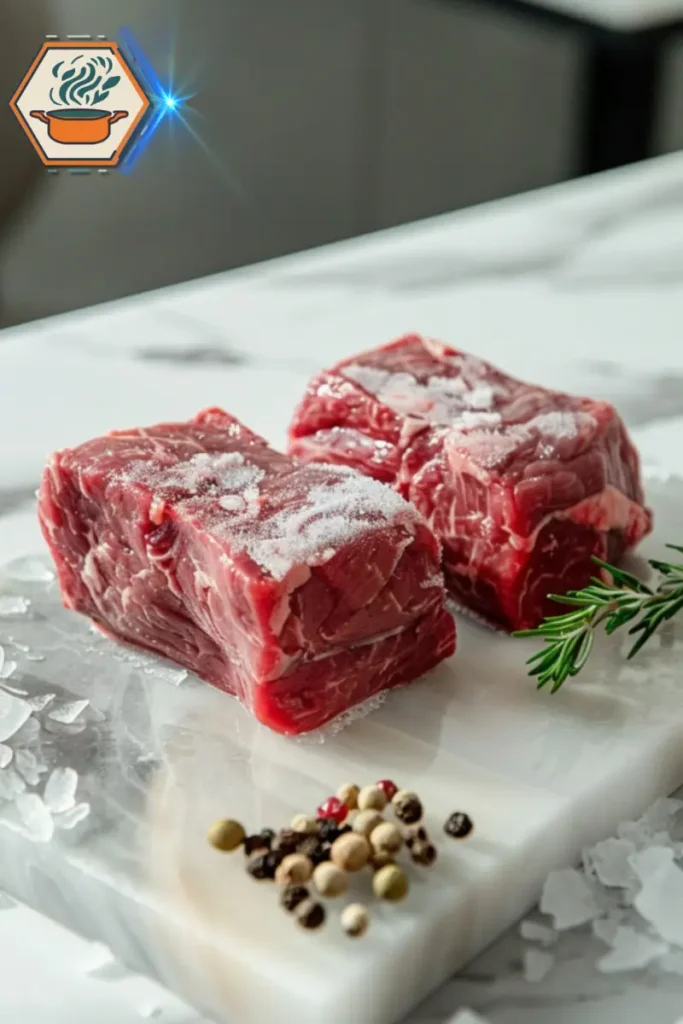
Freezing beef slightly firms up the meat. This lets you slice paper‑thin pieces. Thin slices cook fast, stay juicy, and match the classic texture of philly cheesesteak. Without this, you risk tough or uneven slices.
Flat‑top grill or pan? Choose the right gear
A heavy skillet or cast‑iron pan works fine. But a flat‑top grill gives you more surface area and even heat. Use a tool you control well. If you use a pan, press steak gently to reach full contact with heat. That helps develop browning.
Sauté like a pro: Onions and peppers
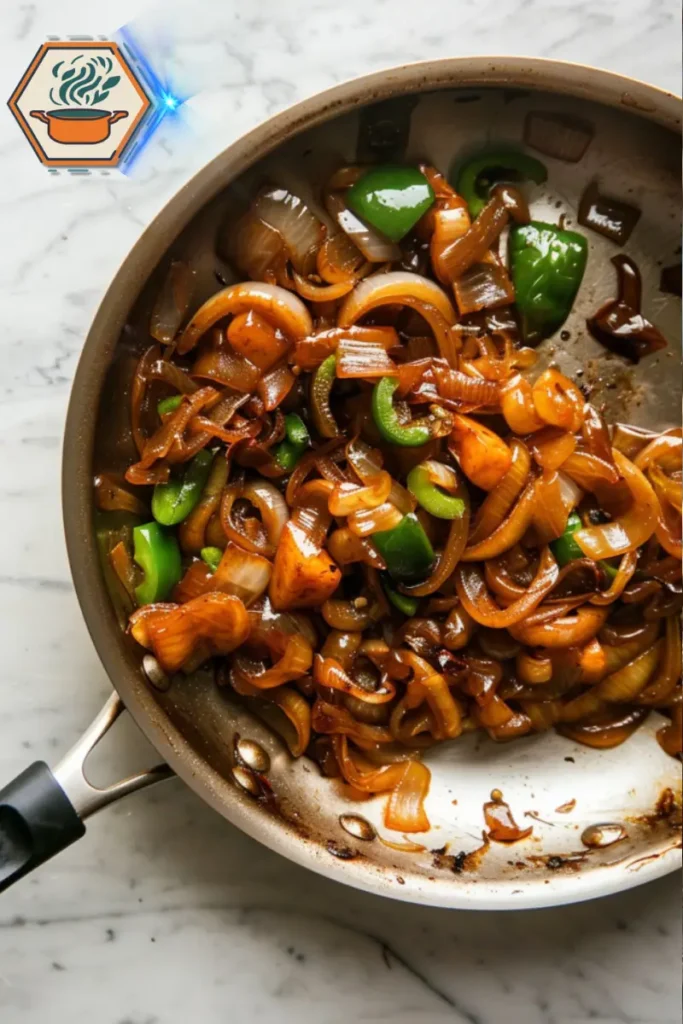
Start onions in hot oil or butter. Let them soften and caramelize gently. Add green peppers only if you like them—they add flavor and crunch. Salt lightly. Don’t rush—slow cooking of onions adds depth. Pepper’s bite adds contrast.
Assembling it all while hot: timing is everything
Once steak is cooked, immediately push it to one side of grill or pan. Melt cheese over it. Slide onions (and peppers) in. Scoop it all into a hoagie roll while very hot. The heat should still be rising. That ensures flavors meld in the bread. Adding the right drizzle makes the difference—our detailed guide on Philly cheesesteak sauce explains how to do it perfectly.
How long should you cook it? Avoiding dryness
Steak needs just a few minutes. Thin slices cook fast—about 2‑3 minutes per side or less to get seared edges but still juicy inside. Overcooking causes dryness. Cheese melts within seconds. Bread toasting takes about 1 minute per side on hot surface.
Best bread for philly cheesesteak and how to toast it just right
Use soft hoagie roll, slightly crusty outside, pillowy inside. Scores along the top help steam release and keep it crisp. Lightly butter or oil the inside, toast cut side on grill until golden. That keeps roll firm but not dried out when full of steak and cheese.
Philly Cheesesteak toppings: A guide to flavor balance
| Component | Purpose | Suggested Amounts |
|---|---|---|
| Cheese | Creamy, melts over steak | Provolone, Cheesesteak Cheese Wiz, or American; 2‑3 slices or ¼ cup shredded |
| Onions | Sweet, mild crunch | ½ medium onion per sandwich |
| Peppers | Heat or color (optional) | ¼ cup sliced, optional |
| Salt & Pepper | Bring out flavors | Pinch salt, fresh pepper to taste |
| Optional extras | Mushrooms, hot sauce, or garlic | Small amounts to not overpower |
How to make a chicken philly cheesesteak with a twist
Swap beef with chicken breast or thigh, sliced thin. Marinade in garlic, paprika, maybe a splash of Worcestershire. Cook same way: sear quickly, add cheese, onions. Option: use pepper jack or mozzarella to match milder chicken flavour. You’ll still get that gooey cheese pull.
Tips from real cooks in South Philly diners
- Use room‑temperature steak to prevent cold center.
- Always preheat grill or skillet to high heat.
- Let meat sit after slicing in freezer so knife slips through.
- Don’t overcrowd pan—work in batches if needed.
- Melt cheese on steak while it rests; then assemble immediately.
If you want to compare technique on how to form texture and juiciness, see method in Perfect Meatloaf Every Time for guidance on resting and slicing meat for max tenderness
Beyond the Classic – Regional Variants, Sides & How to Serve It
Philly cheesesteak has moved far beyond its original simple form. People now enjoy many versions, adaptions, and ways to serve this sandwich. Below are details on these trends and tips to make or enjoy cheesesteak sub in new ways.
Regional Variants & Alternative Styles
Is chicken Philly cheesesteak taking over?
Chicken Philly cheesesteak is growing in popularity. It replaces the classic rib eye or sliced beef. The taste is lighter. For some, it’s a better option — less fat, often easier to eat. Many sandwich shops offer chicken variants alongside beef versions.
Spicy versions: jalapeños and hot sauce trends
Spice lovers are pushing the limits. Jalapeños, hot peppers, or chili sauces are added to the meat or cheese. Some Philly sandwich are served with hot sauce on the side. These spicy versions bring heat and contrast to the melted cheese and tender meat.
Vegan and gluten‑free philly cheesesteak options

Now, more people want plant‑based or gluten‑free diets. Vegan versions use seitan, jackfruit, or plant‑based beef alternatives. Dairy‑free cheeses or cashew cheeses replace provolone or Cheez Whiz.
Gluten‑free rolls or lettuce wraps are used so people with gluten intolerance can still enjoy a “philly cheesesteak feeling.”
What to serve with a philly cheesesteak?
French fries
Crispy fries are a classic side. Regular or waffle‑cut, thin or thick, salted well. They absorb grease, balance richness. Sweet potato fries are another version some places now offer.
Onion rings
Onion rings offer crunch and sweet onion flavor. They contrast well with soft roll and melty cheese in the sandwich. Some sandwich joints dip rings in batter, some in breadcrumbs.
Pickles
Pickles cut through richness. Dill or bread and butter pickles are common. Pickles balance fat and make each bite fresher.
Drinks that pair well (including local Philly beers)
Carbonated drinks help cleanse the palate. Soda, iced tea, or local beers work well. In Philadelphia, many enjoy a local craft beer with a cheesesteak. Light lagers or pilsners complement better than heavy dark beers.
Meal Timing & Serving Suggestions
Is it lunch, dinner, or midnight snack?
Philly cheesesteak works at almost any hour. Lunch is the most common time. Dinner works too, especially with a side and drink.
Because it’s filling, some enjoy it late at night, after events or a night out. Food trucks often offer it until late.
Best way to store and reheat leftovers
If you have leftovers, store meat and cheese separately if possible. Use airtight containers.
To reheat: oven or toaster oven is best. Low‑medium heat, cover with foil so the bread doesn’t dry out. Microwaves work in a pinch, but the roll often becomes soggy.
Where & How to Enjoy
From food trucks to fine dining: where to enjoy the best
Street vendors often have authentic versions: simple, fast, good quality meat and roll.
Fine dining restaurants might offer premium variants: wagyu beef, truffle oil, gourmet cheeses, exotic rolls. Both have appeal.
Philly Cheesesteak around the world: Japan, Canada & more
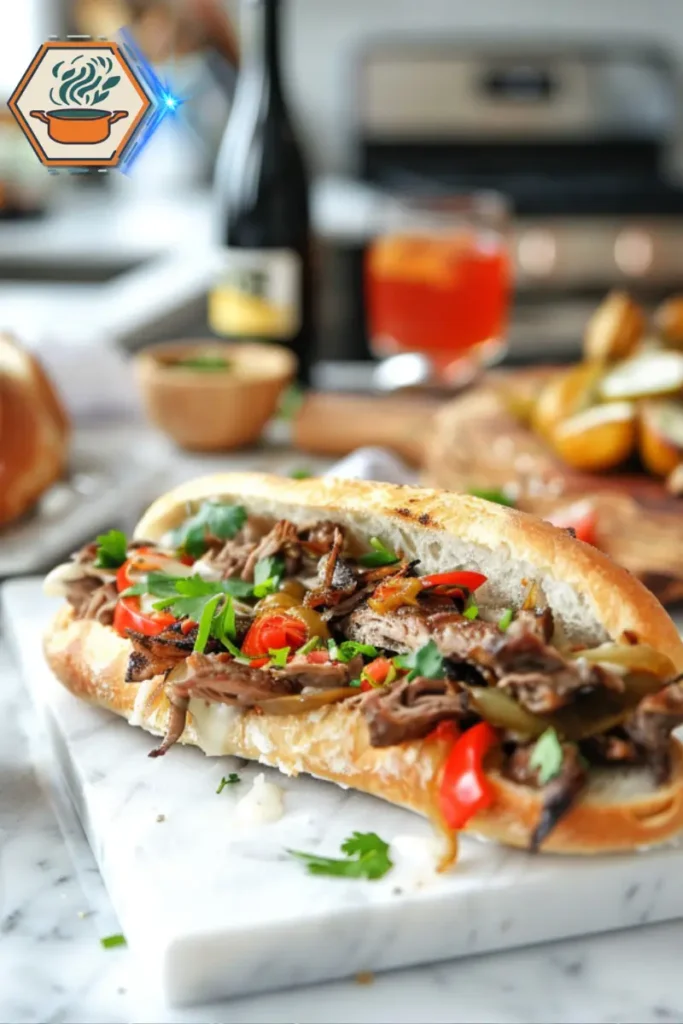
Worldwide, cooks have adapted the sandwich. In Japan, there are versions with local bread and sauces. In Canada, some shops use steak cuts available locally, adapt cheeses.
These global versions keep the core idea: tender meat, melted cheese, good roll.
Storage, Trends & Serving Tips — Table
| Aspect | What to Aim For | Why It Matters |
|---|---|---|
| Bread quality | Soft inside, crust firm, roll that holds fillings | Prevents sogginess; supports meat and cheese |
| Meat cut & preparation | Thin‑sliced or chopped rib eye or alternative; well browned | Flavor and texture matter; overcooked meat loses juice |
| Cheese choice | Provolone, Cheez Whiz, or dairy‑free substitutes | Each gives different melt, flavor, tradition |
| Toppings & condiments | Onions, peppers, mushrooms, optional spice | Adds flavor layers; people like customizing |
| Sides & drinks | Fries, onion rings, pickles; light drink or local beer | Complements the richness of the sandwich |
Throughout this revival of philly cheesesteak, one sees more customization while keeping respect for the roots. Whether it’s a vegan version, a spicy kick, or pairing with a fine craft beer, the core remains: simple, cheesy, meaty, comforting.
You might enjoy trying modern side suggestions like those in Are Acai Bowls Healthy as an alternative fresh side or dessert after a heavy cheesesteak.
For deeper history, National Geographic’s article “The story behind the Philly cheesesteak” shows origins, evolutions, and how cheese was introduced. National Geographic
Conclusion
Philly cheesesteak has grown beyond its classic form. Regional variants, vegan/gluten‑free options, spicy adaptations, and quality sides all expand its appeal. Proper preparation, good bread, the right cheese, and tasty accompaniments make a big difference. Whether for lunch, dinner, or a late snack, authentic Philly roll continues to be a beloved, versatile sandwich that resonates around the world.
FAQ – Philly Cheesesteak
What is on a traditional Philly cheesesteak?
A traditional Philly sandwich has thin-sliced ribeye, grilled onions, and melted cheese on a soft Italian roll. Simple, hearty, and authentic.
What is the secret to a good Philly cheesesteak?
The secret is thinly sliced ribeye cooked quickly on high heat, soft rolls that hold the juices, and cheese that melts right into the meat. Timing is everything.
What is the secret ingredient in cheesesteak sub?
Cheez Whiz is often called the “secret ingredient.” It gives the sandwich its creamy, bold flavor and has been a classic choice since the 1950s.
What sauce goes on a Philly cheesesteak?
Traditionally, no sauce is needed. The juicy beef and cheese create enough flavor. Some modern versions add hot sauce or ketchup, but purists stick to the basics.
What are the essential toppings for a cheesesteak?
The essentials are grilled onions and cheese. Optional toppings include peppers or mushrooms, but too many extras can mask the authentic flavor.
What are common cheesesteak mistakes?
Using the wrong cut of beef, overcooking the meat, adding too many toppings, or using bread that gets soggy are the most common mistakes.
Do you put mayonnaise on Philly cheesesteaks?
Mayonnaise is not traditional. Some shops and home cooks add it, but authentic Philly roll keep it simple with beef, cheese, and onions.
What cheese goes best on a Philly cheesesteak?
Cheez Whiz for the classic version, provolone for sharp flavor, and American cheese for creamy melt. Each has its fans, and many shops let you choose.
What to marinate steak in for Philly cheesesteak?
Authentic Philly cheesesteak usually skips marinades—just salt and pepper. But if you want more flavor, a light mix of Worcestershire sauce, garlic, and olive oil works well.

